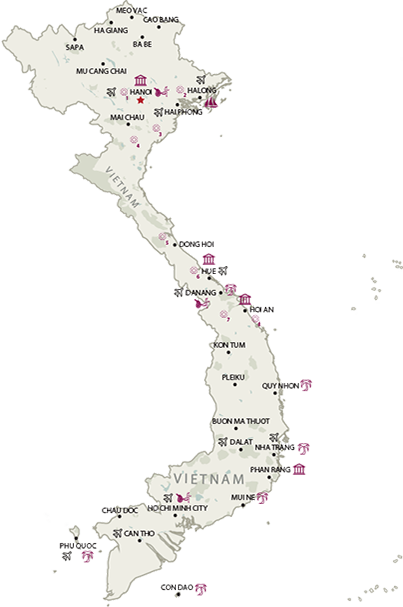Quang Ninh Overview
Quang Ninh is a large province located along the northeastern coast of Vietnam. The province is home to Ha Long Bay, a World Heritage Site. Quang Ninh has a common international border with the People’s Republic of China. Inland, north of province (Binh Lieu, Hai Ha districts and Mong Cai) borders Dongxing City and Fangcheng County in Guangxi Province, PRC with the borderline of 170 km. The province also borders Lang Son, Bac Giang and Hai Duong provinces to the west, and the city of Hai Phong to the south.
Topography
Quang Ninh is a mountainous and coastal province, with more than 80% of its area being made up of mountains and hills. The 2,000 some islands are also considered mountains. The mountainous zone can be divided into two parts: the eastern mountainous region extending from Tien Yen through Binh Lieu, Hai Ha, Dam Ha and Mong Cai; and the western zone ranging from Tien Yen through Ba Che and Hoanh Bo, north of Uong Bi Town. The midland and coastal plains include a low range of hills weathered by both wind and water; forming fields and river basins. They include the zones of Dong Trieu, Uong Bi, northern Yen Hung, southern Tien Yen, Hai Ha and some parts of Mong Cai. The sea and island zone of Quang Ninh has a unique terrain. There are more than 2,000 islands, making up two thirds of the country’s islands. They extend along the coast for more than 250 km and divide into numerous layers. The largest islands are Cai Bau and Ban Sen, while the smallest are just like rocks in a garden. Van Don and Co To are island districts. There are thousands of islands on Ha Long Bay and Bai Tu Long Bay, many of which contain caves.
Climate
Quang Ninh's climate is symbolic of the climate in the North Vietnam; featuring all four seasons. In summer, it's hot, humid and rainy, while monsoons flourish. In winter, it's cold, dry, and sometime rainly. In comparison to other provinces in the north, Quang Ninh has been more under the influences of north-eastern monsoons. The wind blows strongly and the temperature drops to between 1 and 30C. During a north-eastern monsoon, high mountainous regions such as Binh Lieu and Hai Ha, Dam Ha sometimes see the temperature drop below 00C. Storms have a large influence on the province, mainly in June, July and August.
Tourism
There are many beautiful beaches and natural beauty spots for your trip to Vietnam such as Ha Long Bay, Bai Tu Long Bay, Tra Co Beach, Co To Beach, Dai Beach in Van Don etc. Besides, there are historical and architectural relics enabling the development of tours on land, sea and islands. Ha Long Bay covers an area of 1,553 sq. km including 1,969 islands, of which an area of over 434 sq. km including 788 islands has been recognized by UNESCO as a world heritage due to its cultural, aesthetic, bio-geological and economic value. There are in the bay many soil islands, caves, grottoes, beaches, beautiful landscapes enabling the development of attractive tourist sites of various types. Traveling to Ha Long Bay, tourists will have chance to take cruise along the calm waters, between looming, limestone outcrops to visit Dau Go Cave “Grotto of the Wooden Stakes,” where, in 1288, one of Vietnam’s most famous generals, Tran Hung Dao, stored hundreds of stakes before battling the invading Mongolian army, visit the newly discovered Thien Cung Cave (“Grotto of the Heavenly Palace“), famous for its stalagmites and stalactites. Tuan Chau Island belonging to Ha Long Bay has an area of 220ha. It is 8km from Ha Long City and 2km offshore. This is an ideal spot to develop a super tourist complex. Bai Chay Beach is a wonderful spot and provides full range of services. With around 500 historical, cultural and arts relics, attached with many traditional festivals; such as Yen Tu Pagoda, Cua Ong Temple, Bach Dang historical relic, Long Tien Pagoda, Quan Lan Communal House etc, which attract a large number of visitors, especially during festivals.
Transportation
Ha Long Bay is 155km from Hanoi and it will take tourists from 3 – 4 hours to drive to reach the destination.








.png)
